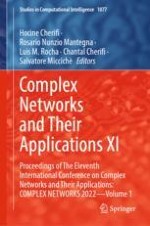2023 | OriginalPaper | Buchkapitel
Detecting Global Community Structure in a COVID-19 Activity Correlation Network
verfasst von : Hiroki Sayama
Erschienen in: Complex Networks and Their Applications XI
Aktivieren Sie unsere intelligente Suche, um passende Fachinhalte oder Patente zu finden.
Wählen Sie Textabschnitte aus um mit Künstlicher Intelligenz passenden Patente zu finden. powered by
Markieren Sie Textabschnitte, um KI-gestützt weitere passende Inhalte zu finden. powered by
